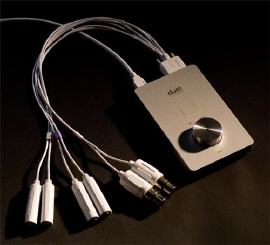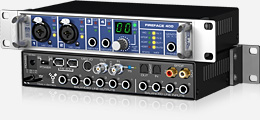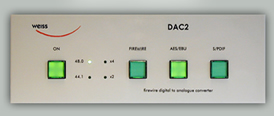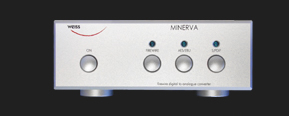- Connecting audio
- Audio PC
- Raspberry & Co
- All in Ones
- Bluetooth
- Chromecast
- Streaming audio player
- Music server
- USB Audio
- Real-time audio over IP
- FireWire DAC
- Multi-channel DAC
- NAS
- Remote control
- Vinyl rippers
- Acoustic materials
- Active crossover
- Active speakers
- Single driver speakers
- Invisible speakers
- Sound card
- Digital room correction
- Headphone
- Portable media players
FireWire
FireWire is Apple's trademark for the IEEE 1394 family of standards. FireWire 400 is "S400" IEEE 1394a and is capable of roughly 400 Mbit/sec and uses the rugged 6-pin socket (not the abominable 4-pin socket). FireWire 800 is "bilingual S800" IEEE 1394b-2002 and uses a 9-pin socket.
Source: Michael Johas Teener
Firewire was a popular bus in the pro-world to connect the AD/DA converter to the PC.
It offered a performance USB1 couldn’t match.
Using USB2 or 3, performance is not the issue anymore.
PC’s with a Firewire interface are becoming rare.
USB simply rules.
Even Apple, the one who made Firewire popular, has dropped it.
FireWire was phased out of Mac hardware between 2008 (when the MacBook Air released without a FireWire port) and 2012 (when the last FireWire-equipped Macs came out).
Interface
The TC Audio DICE chip is often used for the Firewire connection.
A lot of Firewire DACs use adaptive mode just like their USB counterparts.
Other than Metric Halo all the Firewire protocols work the same way adaptive does. That means any company using TC Electronics Firewire (From the Oxford set).
Only Metric Halo has an Async Firewire setup, everyone else is not.
J. Gordon Rankin
Jitter
On the audiophile forums they discuss jitter.
The proponent of Firewire claimed it to be jitter free.
It isn't.
Julian Dunn explains why.
Sample clock jitter and real-time audio over the IEEE1394 high performance serial bus
Hardware
Some examples of DACs with Firewire interface (2010).

Apogee Duet US$495.00
- Two channels of professional-quality 24-bit/96kHz audio input and output
- Two balanced XLR inputs, with selectable 48V phantom power on each input
- Two unbalanced high impedance instrument inputs
- One high-level stereo headphone output
- Two unbalanced -10 dBV line outputs for powered speakers
- Multi-function controller knob for volume and input gain control and assignable MIDI control
- Multi-segment LED meters to display input or output levels
- FireWire 400, compatible with Mac OS X Core Audio
- Control functions built directly into Apple’s Logic Pro, Soundtrack Pro and GarageBand
- Compatible with any Core Audio-compliant audio application
- Apogee’s Maestro software for advanced control and low latency mixing
- Dimensions: 4" W x 6.3" L x 1.5" H
Metric Halo Mobile I/O ULN-2 $1,695.00

- 2 Mic/Line/Instrument analog inputs on Neutrik Combo connectors
- Balanced TRS analog sends and returns for analog inputs
- 2 analog outputs on balanced TRS connectors
- 24bit/96k converters on all channels
- Headphone amp with front panel volume knob
- Balanced stereo master control room monitor output with front panel volume control
- AES-S/PDIF Digital I/O with selectable SRC
- Onboard 80-bit multibus mixer for near-zero latency mixing and routing
- 4-pin XLR power port for compatibility with most location battery systems
- 9 front panel preset system/routing memories for stand-alone operation
- FireWire Connectivity
- Compact, light, and bus-powerable
PrismSound Orpheus $4,495.00

- ASIO and WDM drivers provided for Windows XP and VISTA
- Directly compatible with CORE AUDIO on Mac OS X 10.4+ (Intel & PPC)
- Eight "Prism Sound" premium-quality AD and DA channels
- Concurrent operation of ADAT and switchable S/PDIF or AES3 ports
 RME Fireface 400 $1299.00
RME Fireface 400 $1299.00
Input AD: 6 x 1/4" TRS (4 x Line, 2 x Line/Instrument), 2 x XLR/TRS Combo connector (2 x Mic/Line), all servo-balanced.
Output DA: 6 x 1/4" TRS, servo-balanced, DC-coupled signal path. 1 x 1/4" TRS unbalanced
Input Digital: 1 x ADAT optical or SPDIF optical, SPDIF coaxial (AES/EBU compatible)
Output Digital: 1 x ADAT optical or SPDIF optical, SPDIF coaxial (AES/EBU compatible)
MIDI: 2 x MIDI I/O via breakout cable (4 x 5-pin DIN jacks), for 32 channels low jitter hi-speed MIDI
2 x FireWire 400
Dynamic range AD: 110 dB RMS unweighted, 113 dBA
THD AD: < -100 dB (< 0.001 %)
THD+N AD: < -98 dB (< 0.0012 %)
Crosstalk AD: > 110 dB
Dynamic range DA: 110 dB RMS unweighted, 113 dBA (unmuted)
THD DA: -100 dB (0.001 %)
THD+N DA: -96 dB (0.0015 %)
Crosstalk DA: > 110 dB
Input/Output level for 0 dBFS @ Hi Gain: +19 dBu
Input/Output level for 0 dBFS @ +4 dBu: +13 dBu
Input/Output level for 0 dBFS @ -10 dBV: +2 dBV
Sample rate internally: 32, 44.1, 48, 64, 88.2 kHz, 96 kHz, 128, 176.4, 192 kHz
Sample rate externally: 28 kHz - 200 kHz
Frequency response AD/DA, -0.1 dB: 5 Hz - 20.4 kHz (sf 44.1 kHz)
Frequency response AD/DA, -0.5 dB: 1 Hz - 43.3 kHz (sf 96 kHz)
Frequency response AD/DA, -1 dB: 1 Hz

Weiss DAC2 D/A Converter $3000.00
The DAC2 supports the following conversions:
- FireWire to analog
- AES/EBU to analog
- FireWire to AES/EBU
- AES/EBU to FireWire
Inputs: Digital Audio inputs on FireWire (two connectors), XLR, RCA and Toslink.
Outputs:
- Stereo analog output on XLR and RCA.
- Digital Audio output on FireWire, XLR and RCA.
Sampling Rates, Wordlength: 44.1, 48, 88.2, 96, 176.4, 192 kHz at up to 24 Bits.
Software: Drivers for Windows™ and OSX™ operating systems.
Weiss Minerva $5000.00
Another faceplate, another feet and you have the audiophile version of the DAC2

